Related Research Articles
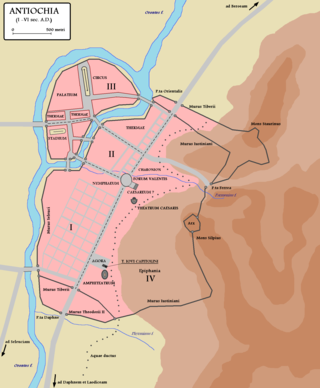
Antioch on the Orontes was a Hellenistic Greek city founded by Seleucus I Nicator in 300 BC. It was one of the greatest and most important Greek cities of the Hellenistic period. The city served as the capital of the Seleucid Empire and later as regional capital to both the Roman and Byzantine Empire. During the Crusades, Antioch served as the capital of the Principality of Antioch, one of four Crusader states that were founded in the Levant. Its inhabitants were known as Antiochenes. The modern city of Antakya, in Hatay Province of Turkey, was named after the ancient city, which lies in ruins on the Orontes River and did not overlap in habitation with the modern city.

Bohemond II was Prince of Taranto from 1111 to 1128 and Prince of Antioch from 1111/1119 to 1130. He was the son of Bohemond I, who in 1108 was forced to submit to the authority of the Byzantine Empire in the Treaty of Devol. Three years later, the infant Bohemond inherited the Principality of Taranto under the guardianship of his mother, Constance of France. The Principality of Antioch was administered by his father's nephew, Tancred, until 1111. Tancred's cousin, Roger of Salerno, managed the principality from 1111 to 1119. After Roger died in the Battle of the Field of Blood, Baldwin II of Jerusalem took over the administration of Antioch. However, he did acknowledge Bohemond's right to personally rule the principality upon reaching the age of majority.
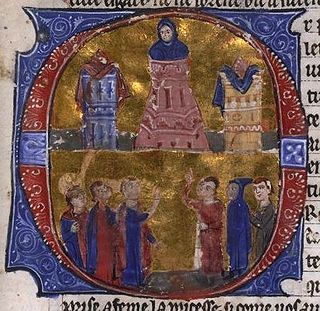
Raynald of Châtillon, also known as Reynald, Reginald, or Renaud, was a knight of French origin who became Prince of Antioch from 1153 to 1160 or 1161 and Lord of Oultrejordain from 1175 until his death. The second son of a French noble family, he joined the Second Crusade in 1147, and settled in the Kingdom of Jerusalem as a mercenary. Six years later, he married Constance, Princess of Antioch, in spite of her subjects' opposition.
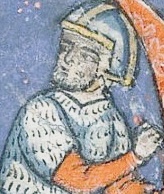
Nūr al-Dīn Maḥmūd Zengī, commonly known as Nur ad-Din, was a member of the Zengid dynasty, which ruled the Syrian province of the Seljuk Empire. He reigned from 1146 to 1174. He is regarded as an important figure of the Second Crusade.

Baldwin II, also known as Baldwin of Bourcq or Bourg, was Count of Edessa from 1100 to 1118, and King of Jerusalem from 1118 until his death. He accompanied his cousins Godfrey of Bouillon and Baldwin of Boulogne to the Holy Land during the First Crusade. He succeeded Baldwin of Boulogne as the second count of Edessa when he left the county for Jerusalem following his brother's death. He was captured at the Battle of Harran in 1104. He was held first by Sökmen of Mardin, then by Jikirmish of Mosul, and finally by Jawali Saqawa. During his captivity, Tancred, the Crusader ruler of the Principality of Antioch, and Tancred's cousin, Richard of Salerno, governed Edessa as Baldwin's regents.
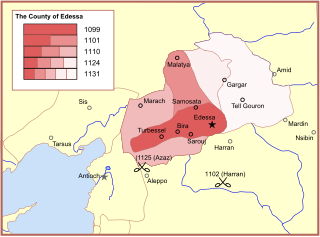
The County of Edessa was a 12th-century Crusader state in Upper Mesopotamia. Its seat was the city of Edessa.

The Principality of Antioch was one of the Crusader states created during the First Crusade which included parts of modern-day Turkey and Syria. The principality was much smaller than the County of Edessa or the Kingdom of Jerusalem. It extended around the northeastern edge of the Mediterranean, bordering the County of Tripoli to the south, Edessa to the east, and the Byzantine Empire or the Kingdom of Armenia to the northwest, depending on the date.

Joscelin II was the fourth and last ruling count of Edessa. He was son of his predecessor, Joscelin I, and Beatrice, daughter of Constantine I of Armenia.
Leo I, also Levon I or Leon I, was the fifth lord of Armenian Cilicia (1129/1130-1137).
Thoros II, also known as Thoros the Great, was the sixth lord of Armenian Cilicia from the Rubenid dynasty from 1144/1145 until 1169.
Mleh I, also Meleh I, was the eighth lord of Armenian Cilicia (1170–1175).
Constance of Hauteville (1128–1163) was the ruling princess of Antioch from 1130 to 1163. She was the only child of Bohemond II of Antioch and Alice of Jerusalem. Constance succeeded her father at the age of two after he fell in battle, although his cousin Roger II of Sicily laid claim to Antioch. Alice assumed the regency, but the Antiochene noblemen replaced her with her father, Baldwin II of Jerusalem. After he died in 1131, Alice again tried to take control of the government, but the Antiochene barons acknowledged the right of her brother-in-law Fulk of Anjou to rule as regent for Constance.

Bohemond III of Antioch, also known as Bohemond the Child or the Stammerer, was Prince of Antioch from 1163 to 1201. He was the elder son of Constance of Antioch and her first husband, Raymond of Poitiers. Bohemond ascended to the throne after the Antiochene noblemen dethroned his mother with the assistance of the lord of Armenian Cilicia, Thoros II. He fell into captivity in the Battle of Harim in 1164, but the victorious Nur ad-Din, atabeg of Aleppo released him to avoid coming into conflict with the Byzantine Empire. Bohemond went to Constantinople to pay homage to Manuel I Komnenos, who persuaded him to install a Greek Orthodox patriarch in Antioch. The Latin patriarch of Antioch, Aimery of Limoges, placed Antioch under interdict. Bohemond restored Aimery only after the Greek patriarch died during an earthquake in 1170.
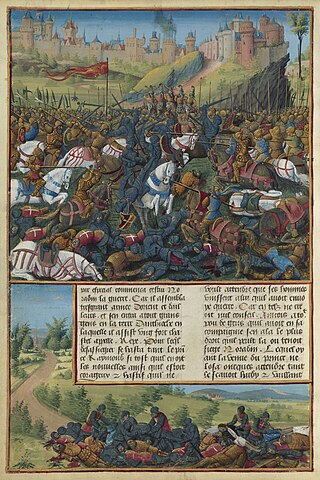
The Battle of Inab, also called Battle of Ard al-Hâtim or Fons Muratus, was fought on 29 June 1149, during the Second Crusade. The Zengid army of Atabeg Nur ad-Din Zangi destroyed the combined army of Prince Raymond of Poitiers and the Assassins of Ali ibn-Wafa. The Principality of Antioch was subsequently pillaged and reduced in size as its eastern border was pushed west.

The siege of Edessa took place from November 28 to December 24, 1144, resulting in the fall of the capital of the crusader County of Edessa to Zengi, the atabeg of Mosul and Aleppo. This event was the catalyst for the Second Crusade.
The Battle of Harim (Harenc) was fought on 12 August 1164 at Harim, Syria, between the forces of Nur ad-Din, and a combined army from the County of Tripoli, the Principality of Antioch, the Byzantine Empire, and Armenia. Nur ad-Din won a crushing victory, capturing most of the leaders of the opposing army.

The timeline of the Principality of Antioch is a chronological list of events of the history of the Principality of Antioch.
The siege of Edessa in October–November 1146 marked the permanent end of the rule of the Frankish Counts of Edessa in the city on the eve of the Second Crusade. It was the second siege the city had suffered in as many years, the first siege of Edessa having ended in December 1144. In 1146, Joscelyn II of Edessa and Baldwin of Marash recaptured the city by stealth but could not take or even properly besiege the citadel. After a brief counter-siege, Zangid governor Nūr al-Dīn took the city. The population was massacred and the walls razed. This victory was pivotal in the rise of Nūr al-Dīn and the decline of the Christian city of Edessa.
Basil the Doctor was an Armenian priest and poet. As the chaplain and confessor of Baldwin, Frankish lord of Marash, he wrote a funeral oration on the latter's death at the battle for Edessa in 1146.
The Lordship of Marash was a territorial lordship in northeastern Cilicia between 1104 and 1149, centred on the city of Marash. One of the lesser Crusader states, it played a major role in the defence of the northern frontier in the 1130s and 1140s under Lords Geoffrey and Baldwin. Its position became untenable after the fall of Edessa in 1146.
References
- ↑ A History of the Crusades: Part 2 The Kingdom of Jerusalem - Steven Runciman (Penguin) - pages 201-202
- ↑ A History of the Crusades: Part 2 The Kingdom of Jerusalem - Steven Runciman (Penguin) - page 240
- 1 2 Linda Paterson, "Syria, Poitou and the Reconquista (or Tales of the Undead): Who Was the Count in Marcabru's Vers de lavador?", in Jonathan Phillips and Martin Hoch, The Second Crusade: Scope and Consequences (Manchester University Press, 2001), pp. 133–149.
- ↑ The Crusades and the Christian World of the East: Rough Tolerance - Christopher MacEvitt - University of Pennsylvania Press - pages 94-97